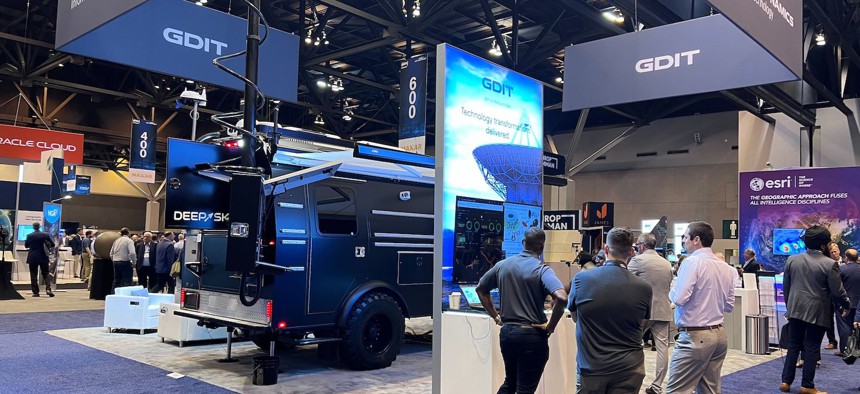GDIT Brought A Truck To A Satellite Show
The tech infrastructure company debuted a mobile mission control and data center built on the chassis of a Ford F-550.
ST. LOUIS—A matte-black Ford F-550 with the word “RAVEN” emblazoned on the side commanded the showroom floor at GEOINT 2023. The truck’s trailer was filled with servers, computer monitors, phones—gear to secure communications and collect data during a disaster response. It was eye-catching and certainly unexpected at a geospatial conference. And it didn’t exist until just weeks ago.
Defense One sat down with Ben Buckley, vice president of General Dynamics Information Technology, to understand what Raven is meant to do:
Buckley: So the idea is that a lot of these [mobile data centers] are more disconnected. They're just like mobile hard drives. They're not necessarily completely integrated into the mission. But the point of this is to be an edge node that's integrated and part of a broader data fabric so that not only can we stage this to be deployed with data, but also that it can do collection where it goes. And that data can actually be used and synchronized. It's supposed to be a more integrated platform and not something you send to go do something with limited capabilities and then is unable to bring any data back to the broader enterprise.
D1: Are there remote capabilities? What about data storage?
Buckley: There's storage on board. You can launch a drone, or it could be other data that you would want to ingest. You could actually take the data ingest it, run machine learning algorithms on that data to search for things and so and to do analysis on that. [With] mobile devices [there’s potential to go] up to five miles with 5G to do analysis on as well. Especially if you get deployed in some sort of constrained environment where there may not be resources and even mobile access, this truck can provide a central point for command and control.
D1: How long can it go without connecting to power?
Buckley: It depends on the load of the truck and what you're actually doing. Days, for sure. As long as you can refuel it, you can run it. But we've been running it pretty much consistently since we got it and it doesn't actually consume as much fuel as we would expect.
D1: Do you anticipate any challenges fielding this for disaster response or military operations?
Buckley: We want to make sure that it has the ability to integrate with the data that it needs to have for the missions that it deploys on. We don't want this to be a standalone system that gets deployed, has static data at rest. We want to be able to integrate with whatever system it needs to so that it can actually have live data, and actually useful data in real time. Because that's one of the large challenges right now: just the sheer amount of data that's available and how do you have a mobile tactical system like this that still stays integrated to that data? And that's one of the main challenges we're trying to solve with this.
D1: That means testing in disconnected environments where there isn’t much service to see how it does?
Buckley: We have multiple ways of connecting through 5G, through satellite. But the idea is that we want our systems to be able to be integrated with the data sources, so that not only when we do local [data collection] that that information can be transmitted back, but when we have to get it sent out that we can quickly stage and get the data downloaded. Because this has to be able to operate without comms if needed; it needs to be survivable by itself.
D1: Is that where the on-board data storage comes in? So operators can refuel on data?
Buckley: A lot of times it's not just data, it's recent data—especially when conditions are changing. Or [the truck] might be collecting more recent data than other people can see. So how do you collect data here and then get that information to others that are not where you are?
D1: So it can store data, pick it up from other sources, and also collect it.
Buckley: And then it can run machine-learning models on the data to look further inside the data that we collect to further identify things.
It's not just the hardware in the form factor, it's the integration. It's more about making this work with data, making sure that we solve the data challenges than almost the platform. So how do we get disconnected operations, have maximum capability, maximum data, ability to collect data, and then the ability to share that. So that's really what this platform is trying to accomplish.





